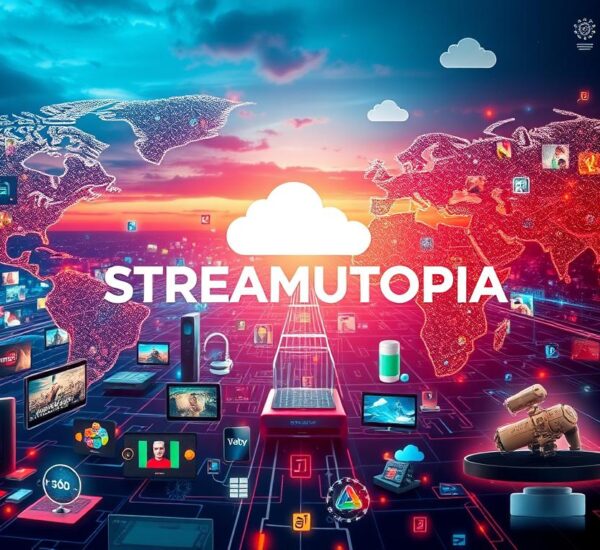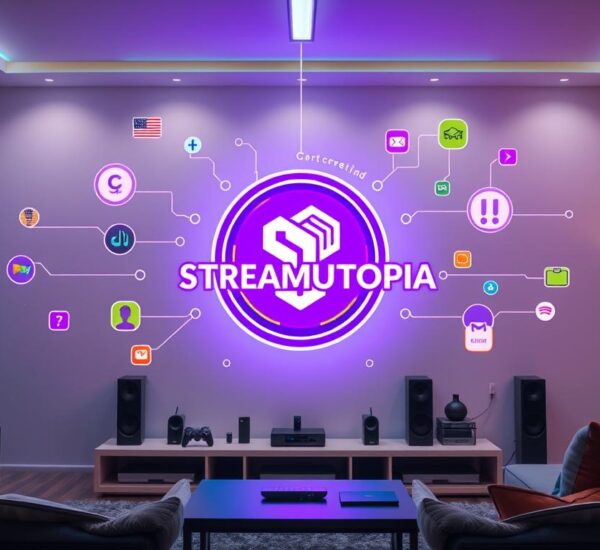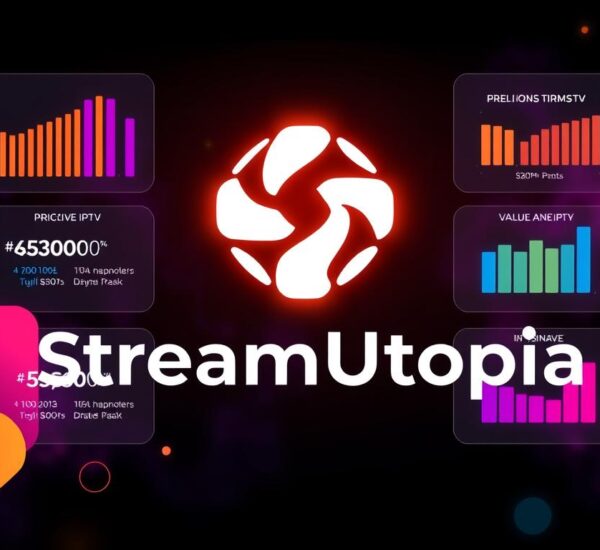Have you ever thought about how millions moved from traditional cable to IPTV subscriptions? Streaming technology keeps changing, making it hard for newbies to understand. This guide will clear up the confusion, showing you how to start with IPTV.
IPTV services offer live TV and video on demand, giving you more than local cable. We’ll look at what to think about when picking an IPTV service. This way, you can enjoy your favorite shows easily.
Key Takeaways
- IPTV services commonly offer live TV streaming, video on demand, and time-shifted media.
- Content offerings, pricing plans, and customer reviews are crucial when selecting an IPTV provider.
- A stable internet connection and an IPTV device are essential for setup.
- Optimizing your experience involves regular firmware updates and securing your network.
- Troubleshooting common issues can often be solved by checking connections and adjusting settings.
Introduction to IPTV
IPTV, or Internet Protocol Television, is a new way to watch TV. It uses the internet instead of cable or satellite. This means you can watch lots of channels and shows online, making it great for those who want more flexibility.
As more people switch from cable, IPTV is becoming very popular. It’s especially good for IPTV for beginners because it’s easy to use.
When you look into IPTV services, you’ll find many options. For example, Hulu + Live TV offers live TV, while Netflix is all about on-demand videos. Services like Peacock TV and BBC iPlayer work on many devices, showing how IPTV fits into today’s TV watching.
These services also have cool features like playback options and an Electronic Program Guide (EPG). These make watching TV even better.
Services like Streamutopia are answering the call for easy and flexible TV watching. They offer lots of channels and high-quality streams. This is perfect for anyone new to IPTV who wants to learn about it and enjoy its benefits.
What is IPTV?
IPTV stands for Internet Protocol Television. It’s a new way to watch TV over the internet, not through satellite or cable. This method lets users stream content directly to their devices, offering more flexibility and choices.
IPTV works by turning TV signals into digital packets. These packets are then sent over the internet. This digital method allows for services like Live IPTV, Video on Demand (VOD), and Time-Shifted IPTV. It shows how diverse IPTV services can be for viewers.
When we look at IPTV basics, we see it differs from traditional TV. IPTV offers better quality, like HD and 4K, and more channels. Users also like the chance to customize their viewing experience.
The choice of IPTV service depends on several things. These include the content library, device compatibility, streaming quality, and price. IPTV services range from simple to full packages, fitting different viewing habits.

IPTV is easy to access. Setting it up usually means downloading an app or using devices like the Nvidia Shield or Formuler Z8. These devices make streaming IPTV smooth. To enjoy IPTV fully, users might need an m3u link for app connection, making paid content easier to access.
In short, IPTV is changing how we watch TV. It combines high-quality entertainment with flexibility. As more people switch to IPTV, knowing about its different types and features will help improve their TV experience.
How Does IPTV Work?
IPTV changes how we watch TV by using the internet to send TV signals. It’s different from old ways like satellite or cable. How IPTV works is simple: it breaks TV signals into digital packets. These packets travel over the internet, letting us watch on devices like smart TVs and phones.
First, you sign up for an IPTV service. Then, the provider sends content over the internet to you. This is where IPTV technology shines. Your device puts the packets together, so you can watch live TV, movies, and more.
- Live Television: Watch shows as they happen, great for sports and live events.
- Time-Shifted Media: Catch up on shows by pausing, rewinding, or recording.
- Video on Demand (VoD): Watch a huge library of movies and TV shows whenever you want.
IPTV has big benefits. It lets you pick what you want to watch, saving money compared to cable. But, you need a good internet connection for smooth streaming.
IPTV isn’t just for local channels. It also has lots of international content. Choosing the right IPTV service means looking at content, quality, and device support. This ensures a great viewing experience for you.
Types of IPTV Services
IPTV services offer many options to fit what users like. There are live TV streaming, video on demand, and time-shifted media. Each type meets different viewing needs, giving users more flexibility and choice.
Live TV Streaming
Live TV streaming lets you watch channels as they air. It’s great for sports fans and news watchers. With a good internet connection, you get instant access to lots of channels, just like regular TV.
For standard definition, you need at least 10 Mbps internet speed. For HD and 4K, you’ll need 25 Mbps or more for the best quality.
Video on Demand (VOD)
Video on demand (VOD) lets you watch a huge library of content whenever you want. It’s perfect for those who love movies or classic shows. You can pick what to watch without being tied to a schedule, making it great for busy people.
Apps like IPTV Smarters and Kodi make it easy to find lots of VOD content. There’s something for everyone.
Time-Shifted Media
Time-shifted media lets you watch shows you missed whenever you want. It shows how flexible IPTV services are. You can catch up on episodes without worrying about when they aired.
With set-top boxes or smart TVs, accessing this feature is easy. You can watch on your own schedule.
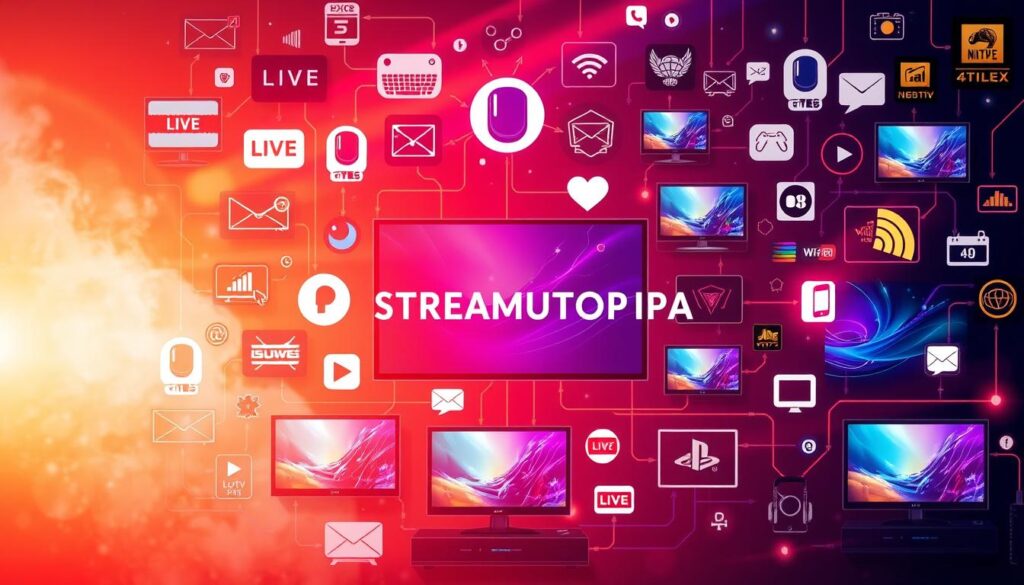
| Type of IPTV Service | Description | Recommended Internet Speed | Popular Devices |
|---|---|---|---|
| Live TV Streaming | Real-time access to channels for live events. | 10 Mbps (SD), 25 Mbps (HD and 4K) | Smart TVs, Set-top boxes, Streaming devices |
| Video on Demand (VOD) | Extensive library of content available for anytime viewing. | 10 Mbps (SD), 25 Mbps (HD and 4K) | Smart TVs, Computers, Tablets |
| Time-Shifted Media | Watch previously aired shows at your convenience. | 10 Mbps (SD), 25 Mbps (HD and 4K) | Set-top boxes, Smart TVs |
Equipment Needed for IPTV
To enjoy IPTV fully, you need the right equipment. First, a stable internet connection is key. For standard definition (SD) streaming, a 10 Mbps speed is best. For HD and 4K, you’ll need at least 25 Mbps to avoid buffering.
The Nvidia Shield is a top choice for IPTV setup. It supports HDR and 4K. Other set-top boxes like MAG, Infomir, and Formuler also work well. You might also want a streaming device like the Amazon Fire Stick, Roku, or Apple TV for better viewing.
Smart TVs from Samsung, LG, and Sony support IPTV natively. This means you don’t need extra hardware. Downloading apps like IPTV Smarters, GSE Smart IPTV, Perfect Player, or Kodi gives you access to many channels.
Setting up IPTV devices costs money. You’ll need to buy equipment and pay subscription fees. These can be from $5 to over $20 a month. There might also be hidden costs like activation fees or extra channel charges. Knowing these costs helps you prepare for IPTV streaming.
Choosing the Right IPTV Service Provider
Finding the right IPTV service is key to a great viewing experience. You need to look at content, prices, and what other users say. This helps you pick an IPTV that fits your needs and likes.
Content Offerings
Providers cater to different tastes. The top ones offer lots of content. For example, Xtreme HD IPTV has over 20,000 live channels and 60,000 VODs. Tivistation has 23,000+ TV channels and 80,000+ movies.
This variety makes your IPTV subscription more valuable. You’ll find shows that you enjoy.
Pricing Plans
It’s important to compare prices to keep your IPTV affordable. Most services have various plans to choose from. For instance, IPTV Holiday offers plans from $9.98/month to $59.98/year.
Liveplayer IPTV’s plans range from $19/month to $128 for two years. Knowing the prices helps you pick the best service.
Customer Reviews and Reputation
What others say is a good guide. Look at reviews to see if a service is reliable and makes users happy. Kemo IPTV and Fubo IPTV are known for their great service and support.
Reading about others’ experiences helps you make a smart choice for your IPTV subscription.

Getting Started with IPTV
Starting with IPTV opens a world of streaming fun. An IPTV setup guide helps new users smoothly install their subscriptions. As IPTV grows in popularity in the US and Canada, knowing how to set it up is key for a great viewing experience.
Subscription Setup
The first step is setting up your IPTV subscription. Here’s how to do it right:
- Pick an IPTV service that fits your viewing tastes. Look at CalmaHUB, Typhoon Labs, or GuekHD IPTV for a wide range of channels and shows.
- Sign up and register on the provider’s website.
- Choose a plan that suits your watching habits. Many offer month-to-month options without long-term contracts.
- Make your payment to complete your subscription setup.
App Installation
After setting up your subscription, installing the app is next. Here’s what to do:
- Download the IPTV app from your device’s app store. You can find it on Amazon Fire Stick, Android, and iOS.
- Open the app and enter your login details from your subscription.
- Customize settings to your liking, like channel lists and favorites.
- With a fast internet connection (at least 10 Mbps for HD and 25 Mbps for 4K), you’re ready to enjoy your shows.
IPTV Subscription Plans
Understanding IPTV subscription plans can greatly improve your viewing experience. These plans come in different categories, offering various choices for consumers. There are affordable IPTV options for everyone, no matter your budget.
The most common model is subscription-based. Users pay a fee, either monthly or yearly. This model is good for providers because it gives them steady income. On the other hand, the pay-per-view model lets you buy access to specific content, like movies or live events. This model is profitable because it offers exclusive content.
For those watching their budget, the ad-supported model is a great option. It offers free or low-cost content in exchange for watching ads. This model is popular because it makes content more accessible to more people.
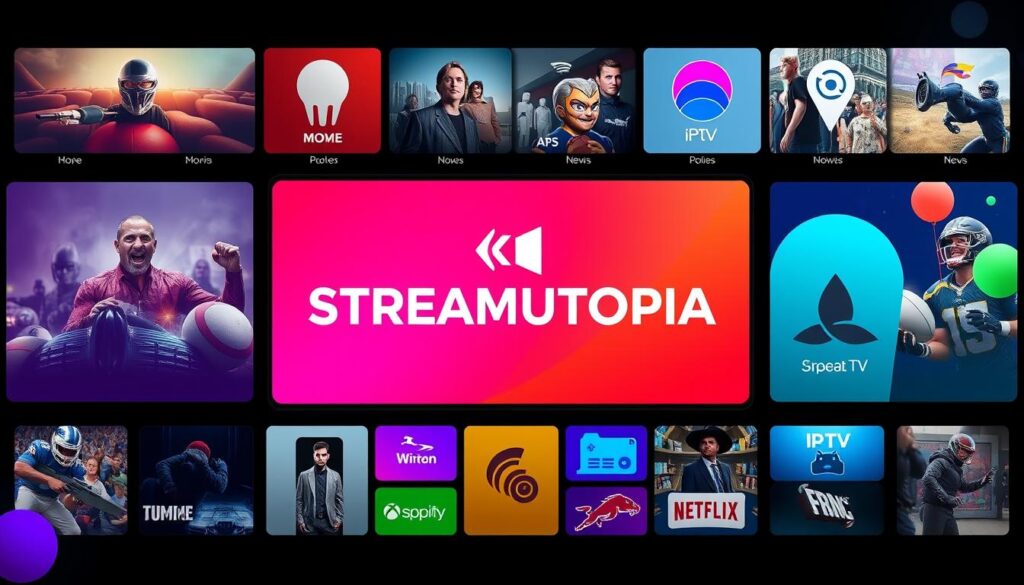
| Provider | Plan Type | Monthly Cost | Channel Count | Special Features |
|---|---|---|---|---|
| TobigoTv | Subscription | $14.99 | Over 400 | Sports Streaming |
| Fubo IPTV | Subscription | $64.99 | 22,000+ | Cloud DVR |
| Nomad IPTV | Subscription | $30.00 | 200+ | International Content |
| Liveplayer IPTV | Subscription | €12.99 | 300+ | Multi-device Support |
| StreamTVUniverse | Pay-Per-View | $3.00 for 24H | N/A | Exclusive Sports Channels |
| IPTV Holiday | Lifetime | $230.00 | Varied | High Definition Streaming |
When comparing IPTV prices, you’ll find many affordable options. This lets you pick a plan that fits your viewing habits and budget. Making an informed choice means you can enjoy your favorite content without spending too much.
IPTV Streaming Options
IPTV streaming options offer a flexible and diverse viewing experience. They match modern viewing habits well. These services work with many devices, making it easy to watch on smart TVs, tablets, smartphones, and computers.
This section looks at the key aspects of device compatibility and user interface. These features make IPTV enjoyable.
Device Compatibility
IPTV services work with many devices, fitting different preferences and lifestyles. Some popular devices include:
- Smart TVs
- Set-top boxes (e.g., Roku, Amazon Fire TV Stick, Apple TV)
- Computers (Windows and Mac)
- Mobile devices (iOS and Android)
This wide range of device support means users can watch their favorite shows and movies anywhere. With high-definition or 4K streaming, IPTV offers a great viewing experience. It’s better than traditional TV services in many ways.
User Interface Features
The IPTV user interface is key to a good user experience. It has important features like:
- Intuitive Navigation: Easy menus help find channels and content fast.
- Search Functionality: Finding shows or movies is simple.
- Personalization Options: Users can customize their experience by favoriting channels or creating watch lists.
A well-designed IPTV user interface makes streaming better. It ensures users can find content easily and enjoy watching without interruptions. The mix of various IPTV streaming options and a user-friendly interface creates a great viewing experience.
| Device | Compatibility |
|---|---|
| Smart TVs | Supported across multiple brands |
| Set-top Boxes | Compatible with popular brands |
| Computers | Windows and Mac platforms |
| Mobile Devices | Supported on iOS and Android |
Navigating IPTV Interface
Learning to navigate the IPTV interface is key to enjoying IPTV services. Knowing the features can make your experience better. Important parts include the channel guide, search, and favorites lists.
The channel guide helps you find live TV easily. It sorts channels by type or popularity. This makes finding your favorite shows simple. The search function saves time by letting you find specific content quickly.
Creating a favorites list adds a personal touch. You can add your favorite channels or shows for quick access. This makes watching your favorite content even easier.
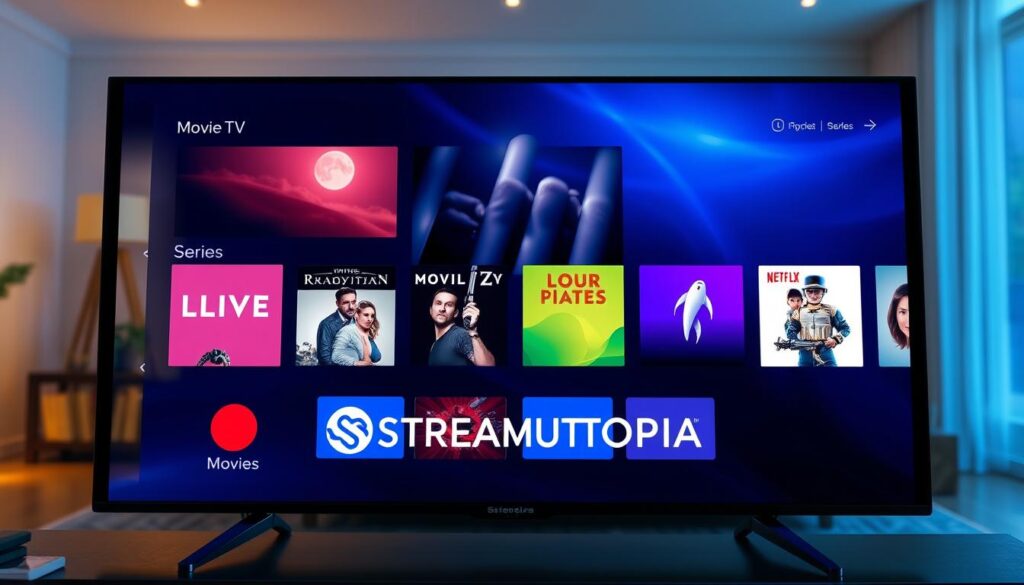
Getting to know the playback controls is also important. Features like pause, rewind, and fast forward let you control your viewing. Keeping your device’s firmware updated ensures you get the latest features and best performance.
In short, getting good at IPTV interface navigation can really improve your experience. By using the channel guide, search, and favorites lists, you’ll find IPTV services more enjoyable and easy to use.
Streaming Quality and Performance
Understanding IPTV streaming quality is key for a great viewing experience. To get smooth content, you need to meet certain bandwidth needs. If bandwidth is too low, you might face buffering, which can ruin the fun of watching live streams.
This section talks about why bandwidth matters and how to fix buffering problems. This will help improve your streaming experience.
Bandwidth Requirements
The quality of your IPTV stream depends on your bandwidth. For the best video quality, you’ll need a certain amount of bandwidth. Here are the minimums for different qualities:
| Streaming Quality | Minimum Bandwidth (Mbps) |
|---|---|
| Standard Definition (SD) | 3-4 |
| High Definition (HD) | 5-10 |
| Ultra High Definition (UHD) | 25+ |
To keep your IPTV stream smooth, a reliable internet connection is a must. Think about how many devices are using your network. This can affect your bandwidth.
Resolving Buffering Issues
Buffering can be a big problem for IPTV users. But, there are ways to fix it:
- Upgrade your internet plan to increase your bandwidth and ensure consistent streaming.
- Limit the number of connected devices while streaming to free up bandwidth.
- Use wired connections instead of Wi-Fi to reduce latency and improve streaming stability.
- Regularly check and optimize router settings to enhance performance.
- Consider utilizing a Quality of Service (QoS) router feature to prioritize streaming traffic over other types of traffic.
Legal Considerations
Using IPTV services comes with big IPTV legal considerations, especially about copyright. It’s key to pick legal IPTV services to avoid legal trouble. In the U.S., laws like the Digital Millennium Copyright Act (DMCA) and the Protecting Lawful Streaming Act are important. These laws make sure content providers have the right to stream copyrighted material. Breaking these laws can lead to big fines.
The Protecting Lawful Streaming Act, passed in 2020, helps the U.S. Department of Justice fight IPTV lawbreakers. Legal IPTV services offer lots of content while following the law. They usually ask for a monthly or yearly fee to stay legal.
Legal IPTV services often come with internet or telecom plans, making them a good deal. But, illegal IPTV services might be based outside the law, offering channels without the right licenses. Be careful of services that ask for payments that can’t be traced or have too many ads. These signs might mean the service is illegal.
Getting caught with illegal IPTV can lead to serious trouble, like up to 10 years in jail. Knowing the difference between legal and illegal IPTV services is crucial for safe viewing.
| Aspect | Legal IPTV Services | Illegal IPTV Services |
|---|---|---|
| Content Licensing | Compliant with licensing agreements | Often lacks necessary licenses |
| Subscription Costs | Reasonable, typically starting from $10.99 | Low costs raise suspicion |
| Payment Methods | Standard payment options available | Encourages untraceable payments |
| Streaming Quality | High-quality streaming up to 4K | Often lower-quality video and audio |
| Ad Experience | Minimal ads, user-friendly | Excessive advertisements |
Tips for Optimizing Your IPTV Experience
To improve your IPTV experience, take a few simple steps. Make sure your network is secure and update your firmware regularly. These tips will make your viewing experience better.
Network Security
Keeping your network safe is key when using IPTV. Bad streaming quality and security risks can come from unauthorized access. Here’s how to boost your network security:
- Use a strong password: Make sure your Wi-Fi and IPTV device passwords are strong and unique to keep out unwanted access.
- Employ a firewall: Firewalls can protect your network from outside threats.
- Disable remote access: Only turn on remote access when you need it to lower the risk of hacking.
- Regularly check for unknown devices: Keep an eye on devices connected to your network and remove any you don’t recognize.
Firmware Updates
Staying up-to-date with IPTV is vital for better performance and security. Updates fix bugs and add new features. Here are some tips for updating effectively:
- Enable automatic updates: If your IPTV device can auto-update, turn it on to save time.
- Check for updates regularly: Even with auto-updates, sometimes check manually to catch any missed updates.
- Backup settings: Before big updates, back up your settings to avoid losing your customizations.
By following these tips, you can enjoy your favorite shows securely and without interruption. Focus on network security and keeping your device updated for the best experience.
Common Troubleshooting
Troubleshooting IPTV can seem tough, especially for new users. Knowing how to fix common problems is key. This guide will help you solve issues that might pop up while watching.
Many users face issues like poor signal, frozen screens, or audio-video sync problems. A step-by-step approach is vital for keeping service quality high. Here are some useful fixes:
- Check Internet Connection: Make sure your internet is stable. You need at least 25 Mbps for smooth streaming.
- Reboot Devices: Restarting your router and IPTV device can fix many problems.
- Test Different Connections: Try using Ethernet or WiFi to see which works better.
- Clear Cache: Clearing the IPTV app’s cache might solve ongoing issues.
- Adjust Audio/Video Settings: Tweaking audio and video settings can help with sync problems.
When dealing with IPTV issues, don’t blame your ISP right away. Do a thorough check to find the real cause. Also, don’t go over the allowed number of connections. This can cause service problems.
With this info on common problems and how to fix them, you can enjoy your IPTV more. Knowing how to tackle these issues makes for a better viewing experience.
Future Trends in IPTV
IPTV is getting better fast, with many future trends in IPTV changing how we watch TV. Soon, we’ll see better streaming quality, like high-definition and 4K. This will make watching TV feel more real and fun.
Smart home tech is becoming key in IPTV advancements. It lets you control your TV with ease. You can change channels, set reminders, and find shows without hassle. This makes watching TV more convenient and fun.
Next-gen IPTV will also focus on how easy it is to use. Future interfaces will be simple and smart, showing you shows you might like. This makes finding new content easier and more enjoyable.
But, there are still big challenges like needing a good internet connection and dealing with legal issues. Improving how content is delivered will help make IPTV better. We can expect services to get more reliable and high-quality.
Top providers will keep adding more TV channels and movies. With so many choices, IPTV will focus on quality as well as quantity. This means better streaming services for everyone.
Innovation in next-gen IPTV features will keep the market exciting. It will bring us tools for a better, more connected TV experience. This will meet our changing needs and expectations.
A Beginner’s Guide to IPTV Subscriptions: How to Get Started
Starting your IPTV journey is exciting. You’ve learned about the different IPTV services. These include live TV, video on demand, and time-shifted media. Each offers a unique way to watch, fitting different tastes and lifestyles.
Choosing a provider is important. Look at the content and prices that fit your needs. Also, read customer reviews to make a good choice and be happy with your service.
Having the right equipment is key. You need a fast internet connection and devices like smart TVs or IPTV boxes. Keep your devices updated and your network secure for the best experience.
Remember, legality matters. Stay away from copyright issues and geo-restrictions. The move to on-demand services means more choices. This appeals to those who like to watch what they want, when they want.
Here’s a quick look at some popular IPTV services in the United States:
| Service | Type | Price (Approx.) | Features |
|---|---|---|---|
| Hulu + Live TV | Premium | Starting at $69.99/month | 75+ channels, on-demand content |
| Sling TV | Premium | Starting at $35/month | 40+ channels, live TV, on-demand |
| YouTube TV | Premium | $72.99/month | 85+ channels, DVR included |
| XUMO | Free | Free | 180+ channels available |
| Peacock TV | Free/Premium | Free with premium options | Live sports and channels included |
Starting with IPTV opens a world of entertainment. This guide has prepared you to enjoy IPTV subscriptions. Explore your streaming options and enjoy the flexibility IPTV offers!
Conclusion
In this IPTV conclusion, we’ve looked at the wide range of options IPTV subscriptions offer. These services are changing how we watch TV. With devices like Smart TVs and Android Boxes, and apps like IPTV Smarters and Tivimate, there’s something for everyone.
Choosing an IPTV subscription can save you money compared to cable or satellite. You get access to many international channels without limits. Plus, you can stream in HD or 4K, making your viewing better. You can also pick only the channels you want, saving on costs.
Starting your IPTV journey means considering all we’ve talked about. Use your IPTV subscription to make your entertainment better. With services like StreamUtopia.com, you can find content that fits your tastes. The future of watching TV is now, and with the right tools, you’re ready to enjoy it.
FAQ
What is IPTV?
How do I choose the right IPTV provider?
What equipment do I need for IPTV?
How does setup for IPTV work?
What are the different types of IPTV services?
How can I enhance my IPTV experience?
What should I do if I’m experiencing buffering issues?
Are there legal risks associated with IPTV services?
What trends should I watch for in IPTV technology?



